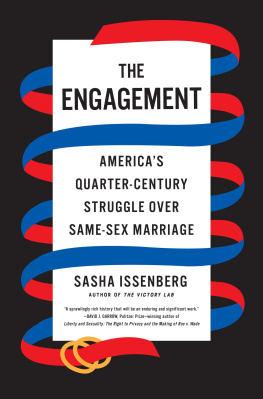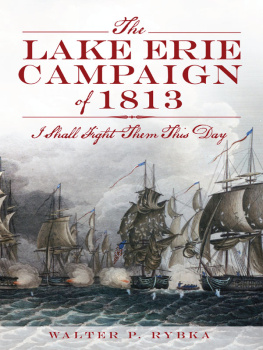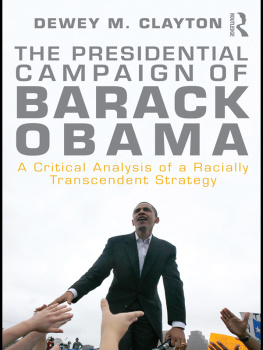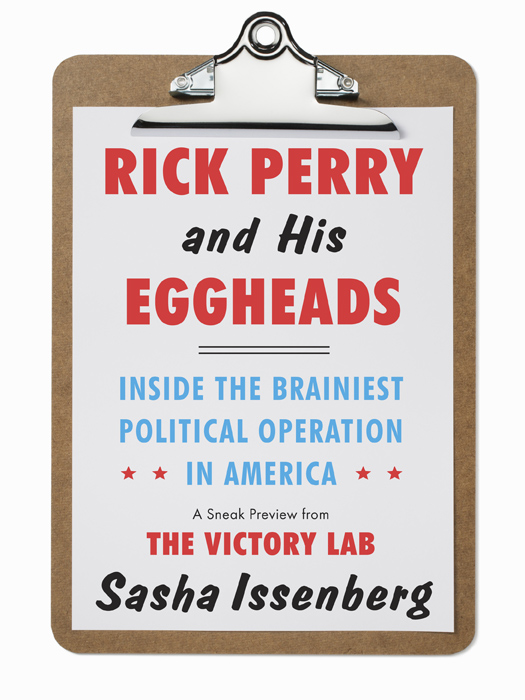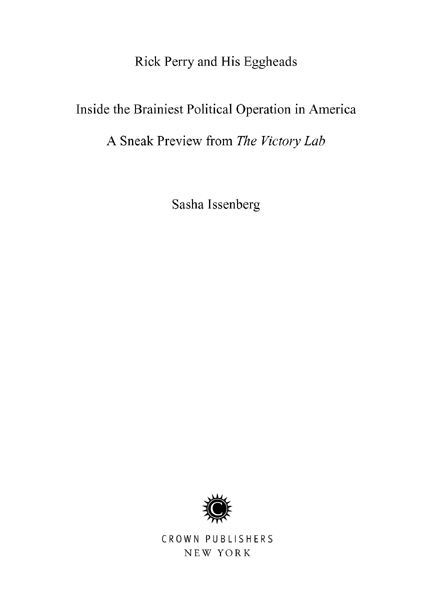A Crown eBook original
Copyright 2011 by Sasha Issenberg
All rights reserved.
Published in the United States by Crown Publishers, an imprint of the Crown Publishing Group, a division of Random House, Inc., New York.
www.crownpublishing.com
CROWN and the Crown colophon are registered trademarks of Random House, Inc.
This material is from the forthcoming book The Victory Lab by Sasha Issenberg to be published in Fall 2012. This excerpt has been set for this edition only and may not reflect the final content of the forthcoming edition.
Library of Congress Cataloging-in-Publication Data is available upon request.
eISBN: 978-0-307-98677-1
Cover design by Christopher Brand
Cover photograph by Gregor Schuster/Getty Images
v3.1
Contents
It was the fight over the lawn signs that made Deirdre Delisi worry that Dave Carney might have finally gone too far. Delisi, a former chief of staff to Texas governor Rick Perry, was a close adviser in his bid for a third term in 2010. Day after day, she would see activists arrive at Perrys headquarters hoping to pick up a sign, and then she would watch the staff explain that there werent anynot now, not next week. The campaign wasnt printing them. This was a difficult thing to tell a Texan. Signs seemed to sprout automatically onto the election-year landscape and they held an enduring place in the lore of Perrys rise. In his first statewide race, in 1990, four-by-eight-foot corrugated-plastic signs that bore the name of the unknown Republican rancher-legislator looking to unseat agriculture commissioner Jim Hightower garnished farm-to-market roads across in the state. Members of the pro-Perry Texas Farm Bureau erected them on the edges of their property.
Now, twenty years later, Perrys far-better-funded gubernatorial campaign was telling its most loyal supporters it wouldnt pay for lawn signs. Delisi went to Carney, Perrys top political strategist, and begged him to spend just $20,000 for a small batch to assuage the activists and save staff the agony of having to calm them. An appeal based on the feelings of either activists or campaign staffers was not an effective way to win a negotiation with Carney. You can never print enough lawn signs! he thundered.
Arguing with the hulking Carney was a futile exercise even for those like Delisi, whoin contrast to the downcast activists retreating from Austin without their beloved signsknew there was a rigor behind his bluster. The New Hampshire native was a journeyman political consultant who each year handled only three campaigns, approaching each with an intensity that could frighten his colleagues as much as his opponents. When he first joined Perrys team, as the agriculture commissioner prepared to run for lieutenant governor in 1998, Carney was an outsider in the often insular world of Texas politics. Now Perry was on his way to his third term as governor, which would make him the longest-serving in Texass history and a plausible contender for the White House. Carney was becoming a familiar archetype in American politicsthe political operative who grooms a local candidate for national office. Carneys contribution to Perrys political career wasnt foremost a strategic sense (as Karl Rove had given George W. Bush) or an aesthetic (as David Axelrod had provided to Barack Obama). Instead Carney brought a deep skepticism about the folkways of campaigning, along with an almost monomaniacal obsession with the potential of scholarly methodologies to upend them.
Carneys unlikely partners in this project were a quartet of political scientists, including two from Yale with a well-known record of collaborating with liberal groups, whom he had invited into Perrys war room with directions to treat it as their laboratory. No political campaign had ever extended such authority to academic outsiders, and it was all the more surprising because Perrys exuberant anti-elitism was quite specific in its disdain for Ivy League credentials. You dont have to have a PhD from Harvard in political science to understand our economics, the governor would say. Yet Carney saw enormous potential in pitting the outsiders he called our four eggheads against the political professionals who surrounded Perry, not only for the contest at hand but for campaigns to come, far into the future. Together they built a multiyear experimental regime to question and test nearly every function of the modern electoral campaign, down to the effectiveness of the humble lawn sign.
In an era of increased specialization among consultants, Carney never aspired to be anything but a generalist. He had been enlisted onto his first campaign in 1978, when a Republican lawyer named Judd Gregg came to Carneys high school social studies class and asked students to go door to door as volunteers on his campaign for New Hampshires executive council. Then in 1980, Carney spent the summer before his junior year at New England College working for John Sununu, a Tufts University engineering professor running in the Republican primary for US Senate. Sununu tapped Carney to be his political director, responsible for organizing town chairmen and arranging house parties where the candidate could meet local voters and activists. Carney became close to Sununu, sleeping in the candidates basement on the nights when he wasnt forced to bunk in the walk-in freezer in the Manchester campaign headquarters that had been converted out of a defunct deli. Sununu lost the Senate race but was elected governor two years later and brought Carney to the State House with him as a political adviser with responsibility for his biennial reelection campaigns.
Early in the 1988 cycle, Sununu endorsed George H. W. Bush for president and dispatched Carney to work on the vice presidents New Hampshire primary campaign. Every Monday at seven a.m., Carney would convene a group of two dozen volunteers he called Bushs Freedom Fighters to methodically trawl through a list of 5,000 party activists and local officials in the state (which may have more elected officeholders per capita than any jurisdiction on earth). The Freedom Fighters would check in with those in their regions and report back on their preferencesthis one is for DuPont, that ones with Kempand then Carney would use computers to update the list and circulate a new one each week.
The Friday before the primary, amid a snowstorm that had debilitated the state, bad news came into Bushs Concord headquarters. Retired general Al Haig was dropping out of the race and planned to endorse Bushs rival, Bob Dole. Carneys office TV was fixed on C-SPAN2, whose cameras showed the empty ballroom at a Manchester conference center where Haig and Dole were to appear together to formalize the endorsement. But Carneys Freedom Fighters were hard at work: Over several hours, they were able to call all seven hundred people in the state who had been tagged as Haig supporters and invite them to back Bush. Carney had Sununu call Haigs leadership team to lobby them to switch too. Many of them were learning the news for the first time when Bushs campaign called; they had yet to hear from Haig or Dole and were open to Bushs pitch. Im convinced we knew more Al Haig supporters in the state than he did because of our canvassing, says Carney. While Dole dominated news coverage, Bush was winning voters to his side. The following Tuesday, Bush won New Hampshire, setting him down a clear path to the nomination and eventually the presidency.


